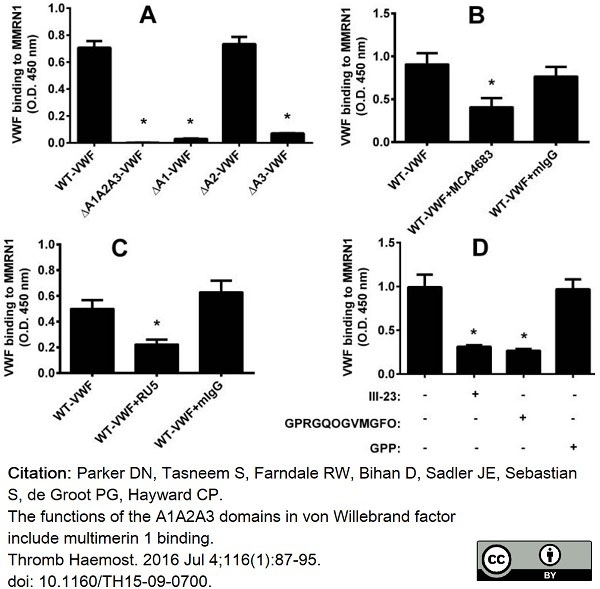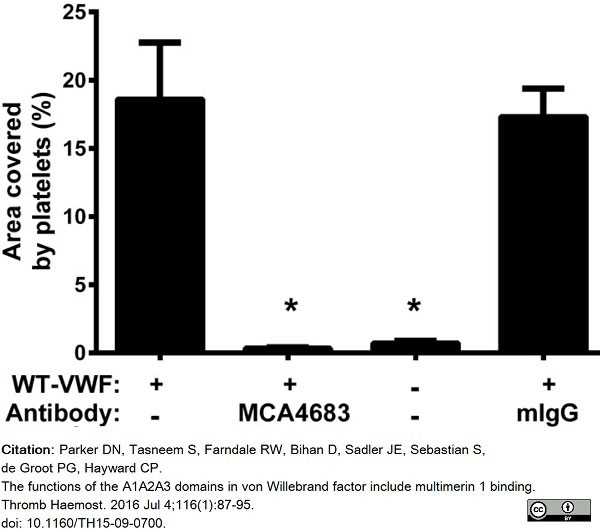von Willebrand Factor antibody | RFF-VIII R/2


Mouse anti Human von Willebrand Factor
- Product Type
- Monoclonal Antibody
- Clone
- RFF-VIII R/2
- Isotype
- IgG1
- Specificity
- von Willebrand Factor
| Mouse anti Human von Willebrand Factor antibody, clone RFF-VIII R/2 recognizes human von Willebrand factor (vWF), also known as Factor VIII related antigen, a blood glycoprotein involved in blood coagulation. It stabilises circulating Factor VIII by binding to it and protecting it from cleavage and delivers it to sites of vascular injury. vWF also promotes the adhesion of platelets to sites of vascular damage by forming a molecular bridge between collagen on exposed endothelial cells and the GPIb binding sites of platelets circulating in the blood. vWF circulates in the blood as large multimers, with each monomer (250 kDa) containing a number of specific domains. Hereditary or acquired defects in vWF lead to von Willebrand disease (vWD), characterised by varying degrees of susceptibility to bleeding. Symptoms might include nosebleeds, bleeding gums, easy bruising, menorrrhagia or gastrointestinal bleeding. Various forms of vWD exist with differing severities, determined by the type of defect. Clone RF-VIII R/2 has a high affinity for an epitope within the platelet GPIb-binding site that is responsible for biological activity. As such the antibody is a potent inhibitor of vWF activity. It can completely neutralise ristocetin-induced platelet aggregation, platelet binding to the subendothelium and ristocetin-induced binding of vWF to platelets. It also inhibits platelet adhesion to glass beads. The epitope recognized is present only on the intact multimeric form of vWF and is abolished by mild denaturation with SDS. The antibody does not recognize human Factor VIII. Mouse anti Human von Willebrand Factor antibody, clone RFF-VIII R/2 may be used to detect vWF in immunoassays in combination with clone Mouse anti Human von Willebrand Factor antibody, clone RFF-VIII R/1 (MCA4682) as a capture reagent. |
- Target Species
- Human
- Product Form
- Purified IgG - liquid
- Preparation
- Purified IgG prepared by affinity chromatography on Protein G from tissue culture supernatant
- Buffer Solution
- Phosphate buffered saline
- Preservative Stabilisers
- 0.09% Sodium Azide (NaN3)
- Carrier Free
- Yes
- Immunogen
- Human Factor VIII complex partially purified from Factor VIII concentrate.
- Approx. Protein Concentrations
- IgG concentration 1.0mg/ml
- Regulatory
- For research purposes only
- Guarantee
- 12 months from date of despatch
Avoid repeated freezing and thawing as this may denature the antibody. Storage in frost-free freezers is not recommended.
| Application Name | Verified | Min Dilution | Max Dilution |
|---|---|---|---|
| ELISA | |||
| Immunohistology - Frozen 1 | 1/25 | 1/100 | |
| Immunohistology - Paraffin | |||
| Protein Purification | |||
| Radioimmunoassays | |||
| Western Blotting |
- 1The epitope recognised by this antibody is reported to be sensitive to formaldehyde fixation and tissue processing. Bio-Rad recommends the use of acetone fixation for frozen sections.
- Histology Positive Control Tissue
- Human tonsil, thymus, liver, spleen or kidney.
References for von Willebrand Factor antibody
-
Goodall, A.H. et al. (1985) An immunoradiometric assay for human factor VIII/von Willebrand factor (VIII:vWF) using a monoclonal antibody that defines a functional epitope.
Br J Haematol. 59 (4): 565-77. -
Goodall, A.H. & Meyer, D. (1985) Registry of monoclonal antibodies to factor VIII and von Willebrand factor. International Committee on Thrombosis and Haemostasis.
Thromb Haemost. 54 (4): 878-91. -
Chand, S. et al. (1986) A two-site, monoclonal antibody-based immunoassay for von Willebrand factor--demonstration that vWF function resides in a conformational epitope.
Thromb Haemost. 55 (3): 318-24. -
Parker, D.N. et al. (2016) The functions of the A1A2A3 domains in von Willebrand factor include multimerin 1 binding.
Thromb Haemost. 116 (1): 87-95.
- Synonyms
- Factor VIII Related Antigen
- RRID
- AB_2257334
- UniProt
- P04275
- Entrez Gene
- VWF
- GO Terms
- GO:0001948 glycoprotein binding
- GO:0002020 protease binding
- GO:0002576 platelet degranulation
- GO:0051087 chaperone binding
- GO:0005783 endoplasmic reticulum
- GO:0005178 integrin binding
- GO:0005518 collagen binding
- GO:0005578 proteinaceous extracellular matrix
- GO:0007597 blood coagulation, intrinsic pathway
- View More GO Terms
- GO:0019865 immunoglobulin binding
- GO:0030168 platelet activation
- GO:0031093 platelet alpha granule lumen
- GO:0031589 cell-substrate adhesion
- GO:0033093 Weibel-Palade body
- GO:0042803 protein homodimerization activity
- GO:0051260 protein homooligomerization
- GO:0047485 protein N-terminus binding
MCA4683
If you cannot find the batch/lot you are looking for please contact our technical support team for assistance.
Please Note: All Products are "FOR RESEARCH PURPOSES ONLY"
View all Anti-Human ProductsAlways be the first to know.
When we launch new products and resources to help you achieve more in the lab.
Yes, sign me up
